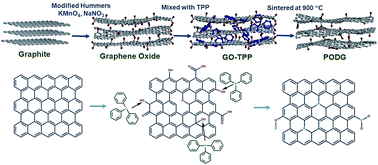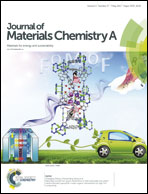Phosphorus and oxygen dual-doped graphene as superior anode material for room-temperature potassium-ion batteries†
Abstract
The intercalation of potassium ions into graphitic carbon materials has been demonstrated to be feasible while the electrochemical performance of the potassium-ion battery (PIB) is still unsatisfactory. More effort should be made to improve the specific capacity and achieve superior rate capability. Functional phosphorus and oxygen dual-doped graphene (PODG) is introduced as the anode for PIB, made by a thermal annealing method using triphenylphosphine and graphite oxide as precursors. It exhibits high specific capacity and ultra-long cycling stability, delivers a capacity of 474 mA h g−1 at 50 mA g−1 after 50 cycles and retains a capacity of 160 mA h g−1 at 2000 mA g−1 after 600 cycles. The superior electrochemical performance of PODG is mainly due to the large interlayer spacing caused by phosphorus and oxygen dual-doping, which facilitates potassium-ion insertion and extraction. Furthermore, the ultrathin and wrinkled features structure leads to a continuous and efficient supply of vacancies and defects for potassium storage.



 Please wait while we load your content...
Please wait while we load your content...